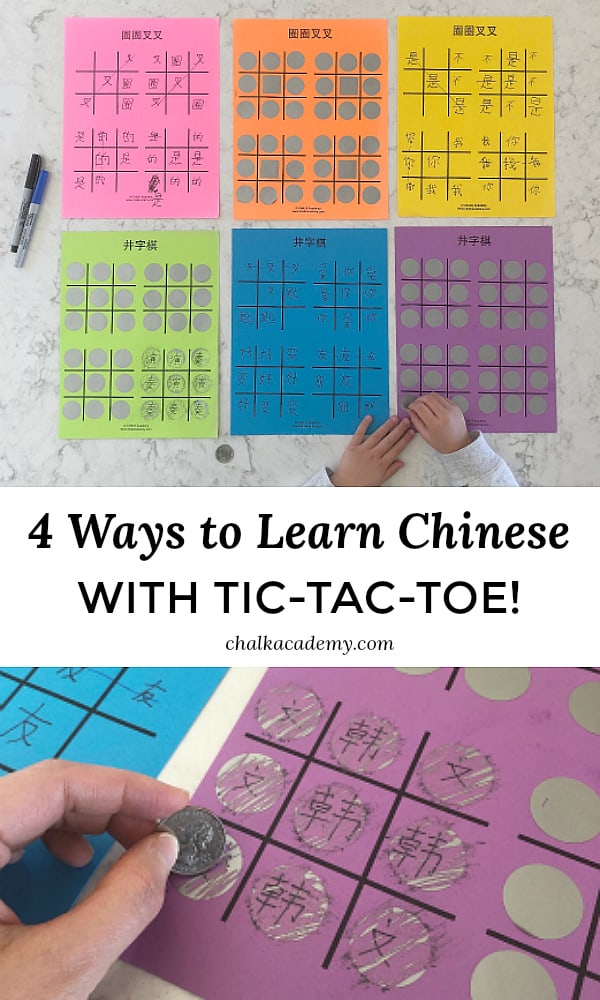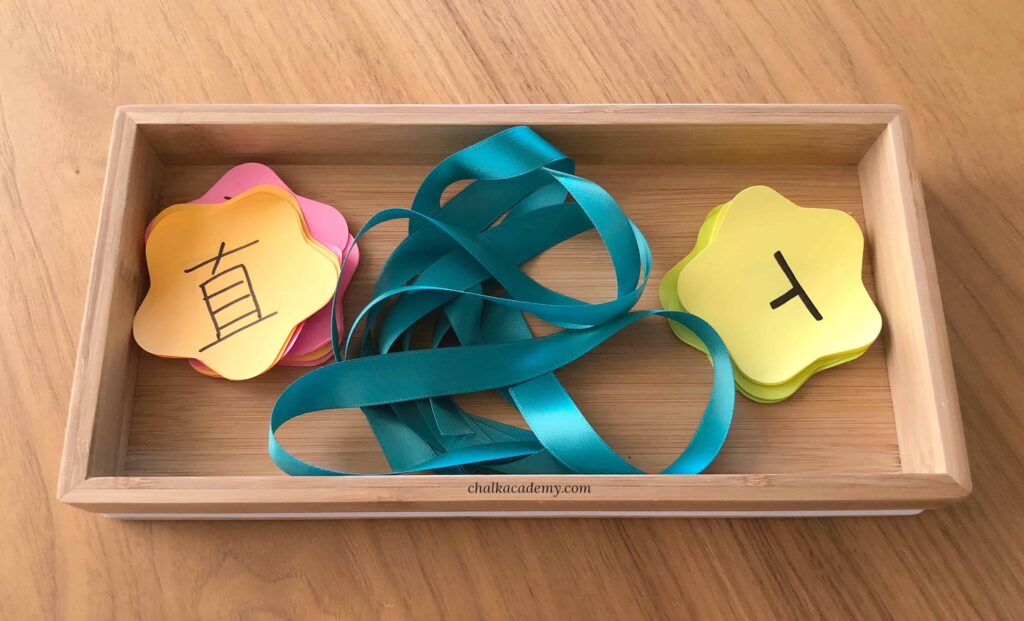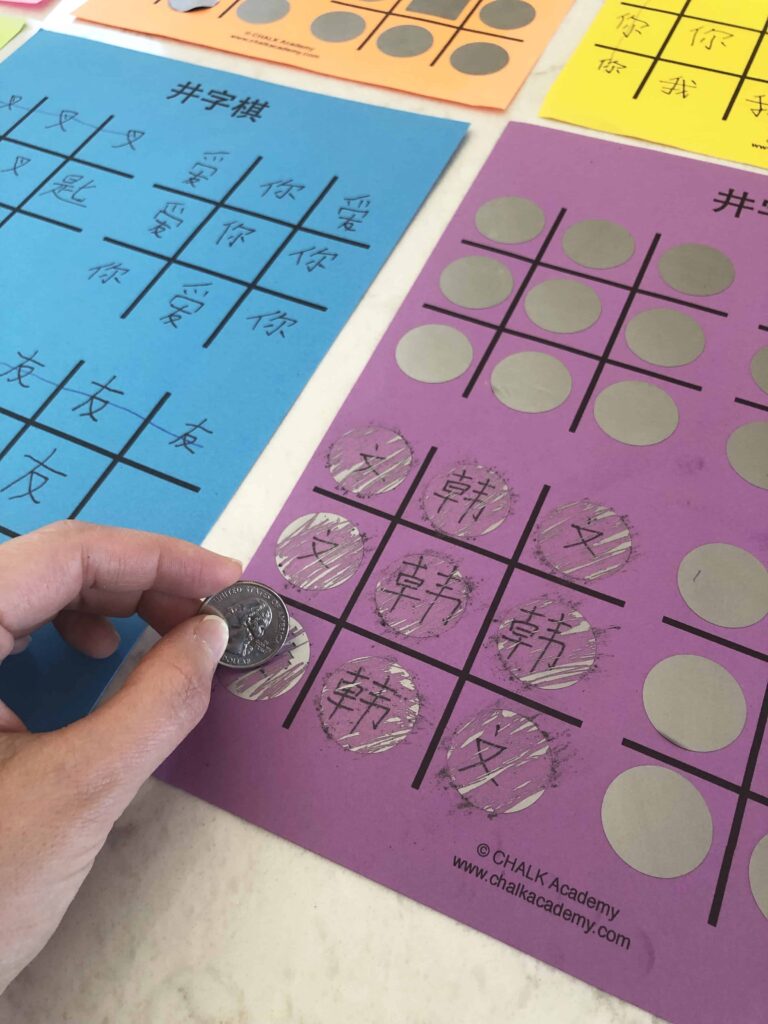Bilingual Tic-Tac-Toe Game Ideas to Teach Language (Printable)

Bilingual tic-tac-toe has been the game of the year!
Since my daughter loves tic-tac-toe, we have been practicing Chinese and Korean reading with this game since last summer.
Tic-tac-toe has been a fun, interactive, and low-prep way for my family to review many new words. It’s a great game for kids ages 4 and up who can understand simple rules and recognize patterns.
In Mandarin Chinese, tic-tac-toe is called 井字棋 (jǐng zì qí) or 圈圈叉叉 (quān quān chā chā) depending on regional preferences.
Chalk Academy is reader-supported. Some of the links are affiliate links. When you buy something through an affiliate link, we may earn a very small commission at no cost to you. Details here.
How to play tic-tac-toe
Young ones can catch on quickly to this game. All you need is five playing pieces for each player and a way to make a grid, either with drawings, ribbons, sticks, or anything else you have on hand.
Each player goes one at a time, placing one of their playing pieces. The goal is to get three of your playing pieces in a row vertically, horizontally, or diagonally. In regards to tic-tac-toe strategy, you also want to try and block your opponent from getting three in a row before you. But for your kids, it’s going to more be about learning!
While we use tic-tac-toe to learn Chinese, you can apply this game to learn just about any language, such as the English alphabet, Spanish, Korean, etc. Start off with learning individual letters or characters, and then work your way up to words and even sentences. You can adapt this however you see fit for your child’s educational experience.
Curious how I play with my kids? Here are four different variations of the tic-tac-toe game that you can play to encourage your child’s language skills.
Fun Ways to Learn Chinese and Korean with Tic-Tac-Toe
The game is easy to set up! You can use a tic-tac-toe board or one of the many different options listed below. However, you can also print our free Chinese tic-tac-toe templates listed at the bottom of this post!
We have played Chinese and Korean tic-tac-toe in many different ways.
Most of the time, we are playing #2 and #4, but see which method appeals to your family!
1. Post-It Note Chinese and Korean Tic-Tac-Toe Game

This first Tic-Tac-Toe game is a fun way to focus on learning two characters at a time. My daughter had fun choosing Post-it Note colors for Chinese tic-tac-toe! Similar characters such as 具 (jù), 真 (zhēn), 且 (qiě), and 直 (zhí) were reviewed so she could learn to identify the difference.
My daughter and her Korean nanny also reviewed Hangul vowels with tic-tac-toe! We used ribbon to create the 3 x 3 grid, and the ribbon and Post-it Notes were in a Montessori-inspired tray, ready to be chosen for playful learning!
Here are some pictures of the Post-it Note Chinese tic-tac-toe game in action:

Please note that we used the same colored Post-it Note for this game so that we would have to focus on distinguishing the Chinese characters. This gets the focus off of playing piece colors and on to placing the right characters in a row.
You can use this technique for learning the English alphabet as well. Write down a few letters in the same color Post-it Note, so your kid has to identify matching letters to place in a row.

We used a black ribbon to form a line through the winning row, but this step is not necessary if you want to save material.
Note: If you can’t write Chinese, you can print out the words on regular paper.

Here is a snapshot of Korean tic-tac-toe with Hangul vowels! My daughter and her nanny played green versus yellow.

2. Chinese Tic-Tac-Toe Writing Practice
Once your child is doing well with character, letter, and word recognition, it’s time to move on to writing! I decided to follow my daughter’s tic-tac-toe interest and implement writing practice within the game!
Some kids may be reluctant to use Chinese writing worksheets, so this is a great activity to try in addition or in lieu of worksheets. Since the tic-tac-toe grid is based on squares, it is the perfect setting for Chinese writing practice.
During the first half of the summer, my daughter used our Chinese stroke order sandpaper cards for reference. You can make your own reference cards for any language using new words you’re trying to learn how to write.
Read more about the Chinese stroke order cards here.
She can now write most of these words correctly from memory!

The beauty of tic-tac-toe is that you can play while waiting at a restaurant, doctor’s office, airport, or any other place with long idle times! While you’re waiting, you might as well get some good practice time in.
This next photo was from a few months ago when we practiced writing 大 (dà / big) and 小 (xiǎo / small) on the restaurant’s kids menu:

I also keep a small notebook and pen in my handbag so we can play tic-tac-toe anytime. As you can see, it gets lots of use!

3. X and O Chinese Tic-Tac-Toe game
This version is the most challenging because 9 Chinese characters are reviewed simultaneously! It’s great once your kids have mastered versions 1 and 2 and have a good grasp of some characters.
To play this version, we used the traditional Xs and Os and said each character out loud while circling and crossing it out.

For example, this round was a tie! In the image below, you can see that we used different colored markers so that the “X” and “O” could be distinguished from the Chinese characters.
This is also a great way to grasp different themes. For example, you could do animals, verbs, foods, etc. Just make sure your child says a word out loud before they cross it out. They can even trace the characters or letters with a marker before marking it out as well.

4. Scratch-Off Surprise Tic-Tac-Toe Game
My daughter loves to use scratch-off stickers to write cards and messages for me. So as a reward for writing practice, I started creating these tic-tac-toe scratch-off surprises!
I knew that combining scratch-off stickers with tic-tac-toe would be a big hit! It can be more interactive than other tic-tac-toe games and is a great method for kids who are reluctant to play the other versions.
To play this version, I wrote two sets of words in a tic-tac-toe grid, including one “winning” set. Then, I covered the Chinese characters with these 1″ round scratch-off stickers, which fit perfectly in our printable!
After, my daughter would use a quarter to scrape off the label to reveal the Chinese characters and see which has a 3-in-a-row winner! She read each character aloud as she scratched them off.

Tip: how to keep a younger child entertained while teaching an older one
I often struggle to keep my younger child busy while teaching my older one, so I try to think of special activities that my son can do next to his big sister.
My son has been into what he calls “Pom Pom 游戏 (yóuxì / game),” and it kept him occupied for 20 minutes while my daughter and I worked on writing practice with this tic-tac-toe game!
Other times, I just draw the tic-tac-toe grid for him while he scribbles over it, pretending to write. 😛 One day, he’ll be playing too!

Free Chinese Tic-Tac-Toe game printables!
Click on the below links to preview and download:
- Version 1: 井字棋 – 4 grids
- Version 2: 圈圈叉叉 – 4 grids
- Version 3: 井字棋 – 1 large grid
- Version 4: 圈圈叉叉 – 1 large grid
I recommend the 4 grid versions if you want to save paper.
The single large grid versions are recommended for young learners who may benefit from seeing large details of each character.
You can even laminate the large grid or put it in a dry-erase pocket sleeve.
Just for fun: Nature Tic-Tac-Toe!
Lastly, I wanted to share our scribble rocks vs. rainbow rocks tic-tac-toe! While my daughter and I made the rainbow rocks, my son joyfully scribbled on his.
Inspired by his scribbles, we ended up making more with him! We drew with Posca paint pens and sealed the rocks with Modge Podge.

If you try Chinese or Korean Tic-Tac-Toe, please let us know!
Tips for teaching kids how to read Chinese
- When and How to Introduce Chinese Characters to Kids?
- 5 Basic Tips for Memorizing Chinese Characters
- Create a Print-Rich Environment with Labels that Promote Literacy
- How I Taught My Child 1000+ Chinese Characters as a Non-Fluent Speaker
- 6 Ways My Child and I Are Learning Mandarin Chinese from Audiobooks
- When Should My Child Learn Hanyu Pinyin?
Happy learning, friends!
